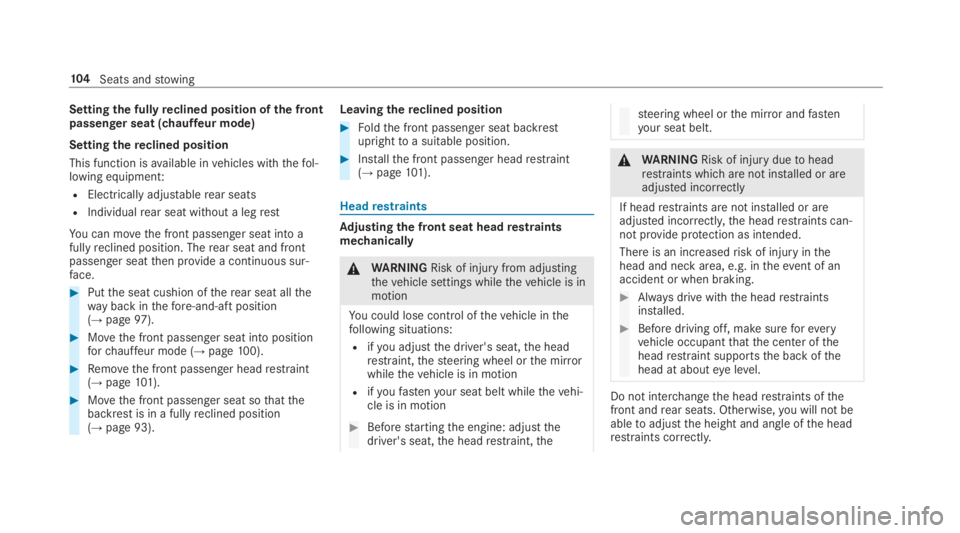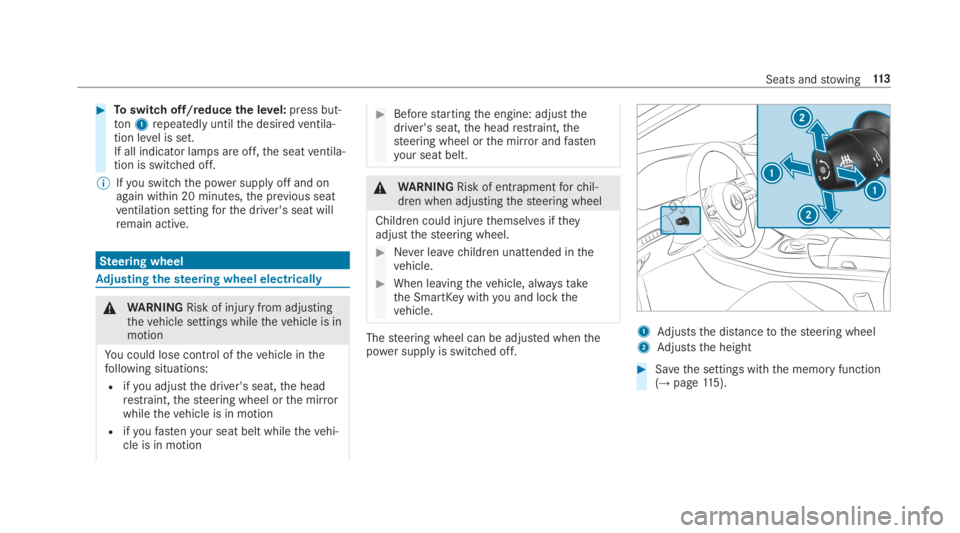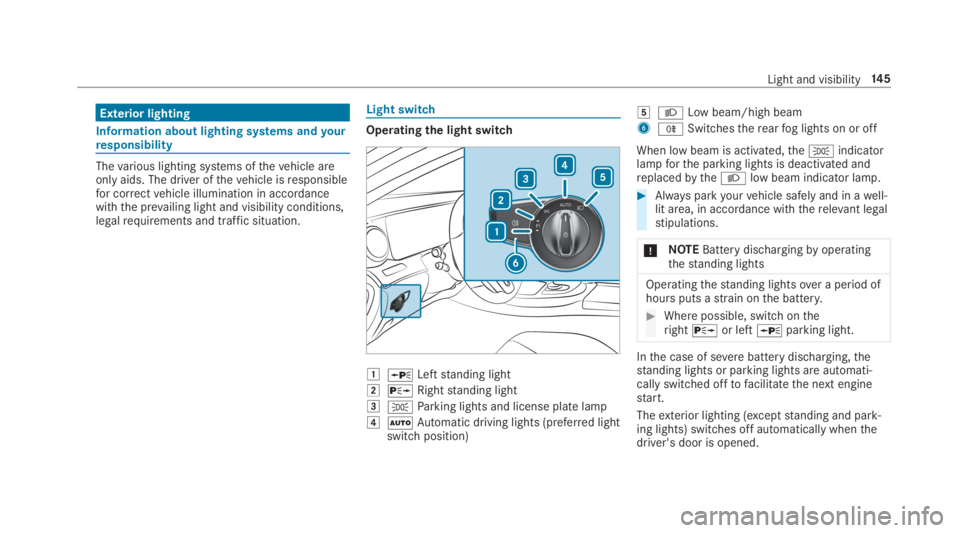2019 MERCEDES-BENZ S CLASS engine
[x] Cancel search: enginePage 92 of 578

Anti-theft protection
Function ofthe immobilizer
The immobilizer preventsyourvehicle from beingstarted withoutthe correct SmartKey.
The immobilizer is automatically activated whenthe ignition is switched off and deactivated whenthe ignition is switched on.
When leavingthevehicle, alwaystakethe Smart‐Key withyou and lockthevehicle. Anyone canstartthe engine if avalid SmartKeyhas been leftinsidethevehicle.
%Intheeventthe engine cannotbestarted(yetthevehicle’sstarter battery ischarged),the system is not operational. Contact anauthorized Mercedes-Benz Center or call1-800-FOR-MERCedes (inthe USA) or1-800-387-0100(in Canada).
ATA(anti-theft alarmsystem)
Function oftheATAsystem (anti-theft alarmsystem)
IftheATAsystem is armed, a visual and audiblealarm is triggered inthefollowing situations:
RWhen a door is opened
RWhenthe trunk lid is opened
RWhenthe hood is opened
TheATA system is armed automatically afterapproximately10seconds:
RAfter lockingthevehicle withthe SmartKey
RAfter lockingthevehicle using KEYLESS-GO.
WhentheATAsystem is armed, indicator lamp1flashes.
TheATA system is automatically deactivated:
RAfter unlockingthevehicle withthe Smart‐Key
RAfter pressingthestart/stop button withtheSmartKeyinsidethevehicle
90Opening and closing
Page 94 of 578

Notes onthe correct driver's seat position
&WARNINGRisk of injuryfrom adjustingthevehicle settings whilethevehicle is inmotion
You could lose control ofthevehicle inthefollowing situations:
Rifyou adjustthe driver's seat,the headrestraint,thesteering wheel orthe mirrorwhilethevehicle is in motion
Rifyoufastenyour seat belt whilethevehi‐cle is in motion
#Beforestartingthe engine: adjustthedriver's seat,the headrestraint,thesteering wheel orthe mirror andfastenyour seat belt.Ensurethefollowing when adjustingthesteeringwheel1, seat belt2and driver's seat3:
Ryou are asfarawayfromthe driver's airbagas possible
Ryou are sitting in an upright position
Ryourthighs are slightlysupportedbythe seatcushion
Ryour legs are not fullyextended andyou candepressthe pedals properly
Rthe back ofyour head is supported ateyelevelbythe center ofthe headrestraint
Ryou can holdthesteering wheel withyourarms slightly bent
Ryou can moveyour legs freely
Ryou can see allthe displaysonthe instru‐ment cluster clearly
Ryou havea goodoverview ofthe traffic con‐ditions
Ryour seat belt is pulled snuglyagainstyourbody and isrouted acrossthe center ofyourshoulder and acrossyour hips inthe pelvicarea
92Seats andstowing
Page 95 of 578

Seats
Adjusting the front seat electrically
&WARNINGRisk of becoming trapped ifthe seats are adjustedbychildren
Children could become trapped iftheyadjustthe seats, particularly when unattended.
#When leavingthevehicle, alwaystakethe SmartKeywithyou and lockthevehicle.
#Never leavechildren unattended inthevehicle.
The seats can be adjusted whenthe ignition isswitched off.
&WARNINGRisk of becoming trappedwhen adjustingthe seats
Whenyou adjust a seat,you orothervehicleoccupants could become trapped, e.g. ontheseat guiderail.
#When adjusting a seat, make surethatno one has any body parts inthe sweepofthe seat.
Observethe safety notes on "Airbags" and "Chil‐dren inthevehicle".
&WARNINGRisk of injuryfrom adjustingthevehicle settings whilethevehicle is inmotion
You could lose control ofthevehicle inthefollowing situations:
Rifyou adjustthe driver's seat,the headrestraint,thesteering wheel orthe mirrorwhilethevehicle is in motion
Rifyoufastenyour seat belt whilethevehi‐cle is in motion
#Beforestartingthe engine: adjustthedriver's seat,the headrestraint,thesteering wheel orthe mirror andfastenyour seat belt.
&WARNINGRisk of becoming trapped ifthe seat height is adjusted carelessly
Ifyou adjustthe seat height carelessly,youorothervehicle occupants could be trappedandthereby injured.
Children in particular could accidentallypressthe electrical seat adjustment buttonsand become trapped.
#While movingthe seats, make surethathands orother body parts do notgetunderthe lever assembly ofthe seatadjustment system.
&WARNINGRisk of injuryduetoheadrestraints which are not installed or areadjusted incorrectly
If headrestraints are not installed or areadjusted incorrectly,the headrestraints can‐not provide protection as intended.
There is an increasedrisk of injury inthehead and neck area, e.g. intheevent of anaccident or when braking.
Seats andstowing93
Page 106 of 578

Settingthe fullyreclined position ofthe frontpassenger seat (chauffeur mode)
Settingthereclined position
This function isavailable invehicles withthefol‐lowing equipment:
RElectrically adjustablerear seats
RIndividualrear seat without a legrest
You can movethe front passenger seat into afullyreclined position. Therear seat and frontpassenger seatthen provide a continuous sur‐face.
#Putthe seat cushion oftherear seat alltheway back inthefore-and-aft position(→page97).
#Movethe front passenger seat into positionforchauffeur mode (→page100).
#Removethe front passenger headrestraint(→page101).
#Movethe front passenger seat sothatthebackrest is in a fullyreclined position(→page93).
Leaving thereclined position
#Foldthe front passenger seat backrestuprighttoa suitable position.
#Installthe front passenger headrestraint(→page101).
Headrestraints
Adjusting the front seat headrestraintsmechanically
&WARNINGRisk of injuryfrom adjustingthevehicle settings whilethevehicle is inmotion
You could lose control ofthevehicle inthefollowing situations:
Rifyou adjustthe driver's seat,the headrestraint,thesteering wheel orthe mirrorwhilethevehicle is in motion
Rifyoufastenyour seat belt whilethevehi‐cle is in motion
#Beforestartingthe engine: adjustthedriver's seat,the headrestraint,the
steering wheel orthe mirror andfastenyour seat belt.
&WARNINGRisk of injuryduetoheadrestraints which are not installed or areadjusted incorrectly
If headrestraints are not installed or areadjusted incorrectly,the headrestraints can‐not provide protection as intended.
There is an increasedrisk of injury inthehead and neck area, e.g. intheevent of anaccident or when braking.
#Always drive withthe headrestraintsinstalled.
#Before driving off, make sureforeveryvehicle occupantthatthe center oftheheadrestraint supportsthe back ofthehead at abouteye level.
Do not interchangethe headrestraints ofthefront andrear seats. Otherwise,you will not beabletoadjustthe height and angle ofthe headrestraints correctly.
104Seats andstowing
Page 115 of 578

#Toswitch off/reducethe level:press but‐ton1repeatedly untilthe desiredventila‐tion level is set.If all indicator lamps are off,the seatventila‐tion is switched off.
%Ifyou switch the power supply off and onagain within 20 minutes,the previous seatventilation settingforthe driver's seat willremain active.
Steering wheel
Adjusting thesteering wheel electrically
&WARNINGRisk of injuryfrom adjustingthevehicle settings whilethevehicle is inmotion
You could lose control ofthevehicle inthefollowing situations:
Rifyou adjustthe driver's seat,the headrestraint,thesteering wheel orthe mirrorwhilethevehicle is in motion
Rifyoufastenyour seat belt whilethevehi‐cle is in motion
#Beforestartingthe engine: adjustthedriver's seat,the headrestraint,thesteering wheel orthe mirror andfastenyour seat belt.
&WARNINGRisk of entrapmentforchil‐dren when adjustingthesteering wheel
Children could injurethemselves iftheyadjustthesteering wheel.
#Never leavechildren unattended inthevehicle.
#When leavingthevehicle, alwaystakethe SmartKeywithyou and lockthevehicle.
Thesteering wheel can be adjusted whenthepower supplyis switched off.
1Adjuststhe distancetothesteering wheel
2Adjuststhe height
#Savethe settings withthe memory function(→page115).
Seats andstowing11 3
Page 123 of 578

Example:vehicles without arecliningrear seat
#Press and holdtherelevant preset positionbutton1,2 or 3 until bothseats are inthestored position.
%The preset positions inthe areaforthechauffeur mode can only be set whentheconditionsforthechauffeur mode are fulfil‐led (→page 99).
%Seat adjustment is interrupted as soon asyoureleasethe preset position button.The adjustment ofthe active multicontourseat isstill carried out.
%You can usetherear-compartmentchildsafety locktodeactivatethis function(→page 60).
Stowage areas
Notes on loadingthevehicle
&DANGERRisk ofexhaustgas poisoning
Combustion engines emit poisonousexhaustgases such as carbon monoxide. Exhaustgases can enterthevehicle interior ifthetrunk lid is open whenthe engine isrunning,especially ifthevehicle is in motion.
#Always switch offthe engine beforeopeningthe trunk lid.
#Never drive withthe trunk lid open.
&WARNINGRisk of injuryfrom unsecureditems inthevehicle
If objects, luggage or loads are not securedor not secured sufficiently,theycould slip,tipover or bethrown around andthereby hitvehicle occupants.
There is arisk of injury,particularly intheevent of sudden braking or a suddenchangein direction.
#Alwaysstowobjects in such awaythattheycannot bethrown around.
#Beforethe journey,secure objects, lug‐gageor loads against slipping or tippingover.
&WARNINGRisk of injuryduetoobjectsbeingstowed incorrectly
Ifyou do not adequatelystowobjects inthevehicle interior,theycould slip or betossedaround andtherebystrikevehicle occupants.In addition, cup holders, openstowagespaces and mobile phone brackets cannot
Seats andstowing121
Page 147 of 578

Exterior lighting
Information about lighting systems andyourresponsibility
Thevarious lighting systems ofthevehicle areonly aids. The driver ofthevehicle isresponsiblefor correctvehicle illumination in accordancewiththe prevailing light and visibility conditions,legalrequirements and traffic situation.
Light switch
Operating the light switch
�G�cLeftstanding light
�H�dRightstanding light
�I�`Parking lights and license plate lamp
�J�XAutomatic driving lights (preferred lightswitch position)
�K�XLow beam/high beam
6�^Switchestherearfog lights on or off
When low beam is activated,the�`indicatorlampforthe parking lights is deactivated andreplacedbythe�Xlow beam indicator lamp.
#Always parkyourvehicle safely and in awell-lit area, in accordance withtherelevant legalstipulations.
*NOTEBattery dischargingbyoperatingthestanding lights
Operatingthestanding lightsover a period ofhours puts astrain onthe battery.
#Where possible, switch ontheright�dor left�cparking light.
Inthe case of severebattery discharging,thestanding lights or parking lights are automati‐cally switched offtofacilitatethe next enginestart.
Theexterior lighting (exceptstanding and park‐ing lights) switches off automatically whenthedriver's door is opened.
Light and visibility14 5
Page 158 of 578

#Ifyou come into contact with electro‐lyte, observethefollowing:RRinsethe electrolyte fromyour skinand seek medical attention immedi‐ately.
RIf electrolyte comes into contactwithyoureyes,rinsethemthor‐oughly with cleanwater and seekmedical attention immediately.
RIfthe electrolyte is swallowed,immediatelyrinseyour mouth outthoroughly. Do not inducevomiting.Seek medical attention immediately.
RImmediatelychange out of clothingwhich has come into contact withelectrolyte.
RIf an allergicreaction occurs, seekmedical attention immediately.
The insiderearview mirror andthe outside mir‐ror onthe driver's side automatically go intoanti-glare mode if light from a headlamp hitsthesensor onthe insiderearview mirror.
System limitations
The system does not go into anti-glare mode inthefollowing situations:
Rthe engine is switched off
Rreversegear is engaged
Rthe interior lighting is switched on
Function ofthe front-passenger outside mir‐ror parking position
The parking position makes parking easier.
The front-passenger outside mirror tilts down‐wards and shows therear wheel onthe front-passenger side inthefollowing situations:
Rthe parking position isstored (→page156)
Rthe passenger mirror is selected
Rreversegear is engaged
The front-passenger outside mirror moves backtoits original position inthefollowing situations:
Ryou shiftthe transmissiontoanother trans‐mission position
Rat speeds greaterthan 9mph (15 km/h)
Ryou pressthe buttonforthe outside mirroronthe driver's side
Storingthe parking position ofthe front-passenger outside mirror usingreversegear
Storing
15 6Light and visibility